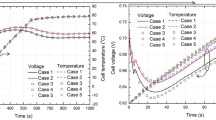Abstract
A model calculation of the startup of a power plant based on a polymer electrolyte membrane fuel cell (PEMFC). The power plant is equipped with a recombiner with a nanostructured hydrogen oxidation catalyst and a bubbler, filled with methanol, which absorbs water vapor, drying the heated air to prevent ice formation inside the fuel cell, which allows for autonomous cold start and operation in the Arctic region. A mathematical model was developed of start-up of PEMFC capacity 1 kW from ambient temperature in the Arctic region to the operating temperature of the fuel cell (warming up from –50 to +50°C). The characteristics of the heating modes were determined for the gradients of the fuel cell heating rate from 0.1 to 0.5°C/s. The proposed scheme of the heating unit and the mode of starting the power plant make it possible to reduce the heating element heating time to the operating temperature to ~6 min, as well as to reduce the volume of the heating unit used and to reduce the consumption of hydrogen supplied in a mixture with air to 3 vol %. The proposed scenario of cold start ensures the temperature stability of the heating unit, which guarantees the safety of heating the fuel cell and the installation as a whole. The use of methanol to remove water vapor from the hydrogen stream and replace them with methanol vapor allows the cold start temperature of the fuel cell to be reduced to -50°C due to the prevention of crystallization of water vapor in the bulk of FC components at the initial stages of heating.





Similar content being viewed by others
REFERENCES
S. I. Kozlov and V. N. Fateev, Transp. Al’tern. Topl., No. 2 (38), 7 (2014).
R. C. McDonald, C. K. Mittelsteadt, and E. L. Thompson, Fuel Cells, No. 3, 208 (2004). https://doi.org/10.1002/fuce.200400015
Q. Yan, H. Toghiani, Y. Lee, et al., J. Power Sources 160, 1242 (2006). https://doi.org/10.1016/j.jpowsour.2006.02.075
M. Cappadonia, J. W. Erning, and U. Stimming, J. Electroanal. Chem. 376, 189 (1994). https://doi.org/10.1016/0022-0728(94)03586-5
M. Sliwinska-Bartkowiak, J. Gras, and R. Sikorski, Langmuir 15, 6060 (1999). https://doi.org/10.1021/la9814642
M. Sliwinska-Bartkowiak, G. Dudziak, R. Sikorski, et al., Phys. Chem. Chem. Phys. 3, 1179 (2001). https://doi.org/10.1039/B009792F
J. Hou, H. Yu, B. Yi, et al., Electrochem. Solid-State Lett. 10, 11 (2007). https://doi.org/10.1149/1.2363952
M. Khandelwal, S. Lee, and M. M. Mench, J. Power Sources 172, 816 (2007). https://doi.org/10.1016/j.jpowsour.2007.05.028
R. Lin, Y. Weng, X. Lin, et al., Int. J. Hydrogen Energy 39, 18369 (2014). https://doi.org/10.1016/j.ijhydene.2014.09.065
Q. Guo, Y. Luo, and K. Jiao, Int. J. Hydrogen Energy 38, 1004 (2014). https://doi.org/10.1016/j.ijhydene.2012.10.067
Y. Tabe, M. Saito, K. Fukui, et al., J. Power Sources 208, 366 (2012). https://doi.org/10.1016/j.jpowsour.2012.02.052
Z. Wan, H. Chang, S. Shu, et al., Energies 7, 3179 (2014). https://doi.org/10.3390/en7053179
L. Yao, J. Peng, J. Zhang, et al., Int. J. Hydrogen Energy 43, 15505 (2018). https://doi.org/10.1016/j.ijhydene.2018.06.112
A. Amamou, S. Kelouwani, L. Boulon, et al., IEEE Access. 4, 4989 (2016). https://doi.org/10.1109/ACCESS.2016.2597058
W. S. Wheat, M. A. Meltser, and D. A. Masten, US Patent No. 8288049 B2 (2012).
Y. Zhou, Y. Luo, S. Yu, et al., J. Power Sources 247, 738 (2014). https://doi.org/10.1016/j.jpowsour.2013.09.023
Y. Li, S. Xu, Z. Yang, et al., in Proceedings of the International Conference on Electric Information and Control Engineering, 2011, p. 5. https://doi.org/10.1109/ICEICE.2011.5776891
N. Henao, S. Kelouwani, K. Agbossou, et al., J. Power Sources 220, 31 (2012). https://doi.org/10.1016/j.jpowsour.2012.07.088
J. Hwang, Appl. Energy 108, 184 (2013). https://doi.org/10.1016/j.apenergy.2013.03.025
F. Knorr, D. Garcia, J. Schirmer, et al., Appl. Energy 238, 1 (2019). https://doi.org/10.1016/j.apenergy.2019.01.036
T. F. Fuller and D. J. Wheeler, US Patent No. 6103410 (2000).
A. Amamou, M. Kidayeni, L. Boulon, et al., Appl. Energy 216, 21 (2018). https://doi.org/10.1016/j.apenergy.2018.02.071
M. Sundaresan, A Thermal Model to Evaluate Sub-Freezing Startup for a Direct Hydrogen Hybrid Fuel Cell Vehicle Polymer Electrolyte Fuel Cell Stack and System (Univ. of California, USA, 2004).
S. Surampudi, S. R. Narayanan, E. Vamos, et al., US Patent No. 5599638 (1997).
A. Kindler, S. R. Narayanan, and T. I. Valdez, US Patent No. 6440594 B1 (2002).
A. Heinzel and V. M. Barragan, J. Power Sources 84, 70 (1999). https://doi.org/10.1016/S0378-7753(99)00302-X
S. Wasmus and A. Küver, J. Electroanal. Chem. 461, 14 (1999). https://doi.org/10.1016/s0022-0728(98)00197-1
A. Christen and J. T. Mueller, US Patent No. 6743538 B2 (2004).
T. Tang, S. Heinke, A. Thuring, et al., Int. J. Hydrogen Energy 30, 1 (2017). https://doi.org/10.1016/j.ijhydene.2017.03.236
H. Meng and B. Ruan, Int. J. Energy Res. 35, 2 (2011). https://doi.org/10.1002/er.1730
H. Meng, J. Power Sources 178, 141 (2008). https://doi.org/10.1016/j.jpowsour.2007.12.035
G. N. Voloshchenko, V. N. Fateev, and N. A. Ivanova, RF Patent No. 194638 U1 (2019)
V. N. Fateev, G. N. Voloshchenko, and N. A. Ivanova, RF Patent No. 2722751 U1 (2020).
D. D. Spasov, N. A. Ivanova, A. S. Pushkarev, et al., Catalysts 9, 1 (2019). https://doi.org/10.3390/catal9100803
S. Sun, H. Yu, J. Hou, et al., J. Power Sources 177, 137 (2008). https://doi.org/10.1016/j.jpowsour.2007.11.012
Funding
This work was supported by the Russian Foundation for Basic Research (project no. 18-29-23030) and within the framework of scientific research at the NRC Kurchatov Institute (order no. 1808).
Author information
Authors and Affiliations
Corresponding author
Rights and permissions
About this article
Cite this article
Voloshchenko, G.N., Zasypkina, A.A. & Spasov, D.D. Model Study of a Cold Start of a Power Plant Based on a Polymer Electrolyte Membrane Fuel Cells in the Conditions of Arctic Temperatures. Nanotechnol Russia 15, 326–332 (2020). https://doi.org/10.1134/S1995078020030155
Received:
Revised:
Accepted:
Published:
Issue Date:
DOI: https://doi.org/10.1134/S1995078020030155



